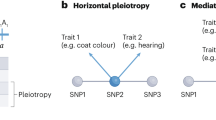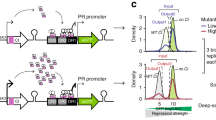Abstract
Experiments in model organisms report abundant genetic interactions underlying biologically important traits, whereas quantitative genetics theory predicts, and data support, the notion that most genetic variance in populations is additive. Here we describe networks of capacitating genetic interactions that contribute to quantitative trait variation in a large yeast intercross population. The additive variance explained by individual loci in a network is highly dependent on the allele frequencies of the interacting loci. Modeling of phenotypes for multilocus genotype classes in the epistatic networks is often improved by accounting for the interactions. We discuss the implications of these results for attempts to dissect genetic architectures and to predict individual phenotypes and long-term responses to selection.
This is a preview of subscription content, access via your institution
Access options
Access Nature and 54 other Nature Portfolio journals
Get Nature+, our best-value online-access subscription
$29.99 / 30 days
cancel any time
Subscribe to this journal
Receive 12 print issues and online access
$209.00 per year
only $17.42 per issue
Buy this article
- Purchase on Springer Link
- Instant access to full article PDF
Prices may be subject to local taxes which are calculated during checkout





Similar content being viewed by others
References
Hill, W.G., Goddard, M.E. & Visscher, P.M. Data and theory point to mainly additive genetic variance for complex traits. PLoS Genet. 4, e1000008 (2008).
Bloom, J.S., Ehrenreich, I.M., Loo, W.T., Lite, T.-L.V. & Kruglyak, L. Finding the sources of missing heritability in a yeast cross. Nature 494, 234–237 (2013).
Bloom, J.S. et al. Genetic interactions contribute less than additive effects to quantitative trait variation in yeast. Nat. Commun. 6, 8712 (2015).
Polderman, T.J.C. et al. Meta-analysis of the heritability of human traits based on fifty years of twin studies. Nat. Genet. 47, 702–709 (2015).
Cheverud, J.M. & Routman, E.J. Epistasis and its contribution to genetic variance components. Genetics 139, 1455–1461 (1995).
Carlborg, O. & Haley, C.S. Epistasis: too often neglected in complex trait studies? Nat. Rev. Genet. 5, 618–625 (2004).
Mackay, T.F.C. Epistasis and quantitative traits: using model organisms to study gene–gene interactions. Nat. Rev. Genet. 15, 22–33 (2014).
Nelson, R.M., Pettersson, M.E. & Carlborg, Ö. A century after Fisher: time for a new paradigm in quantitative genetics. Trends Genet. 29, 669–676 (2013).
Gerke, J., Lorenz, K. & Cohen, B. Genetic interactions between transcription factors cause natural variation in yeast. Science 323, 498–501 (2009).
Le Rouzic, A., Siegel, P.B. & Carlborg, O. Phenotypic evolution from genetic polymorphisms in a radial network architecture. BMC Biol. 5, 50 (2007).
Le Rouzic, A. & Carlborg, Ö. Evolutionary potential of hidden genetic variation. Trends Ecol. Evol. 23, 33–37 (2008).
Carlborg, O., Jacobsson, L., Ahgren, P., Siegel, P. & Andersson, L. Epistasis and the release of genetic variation during long-term selection. Nat. Genet. 38, 418–420 (2006).
Paixão, T. & Barton, N.H. The effect of gene interactions on the long-term response to selection. Proc. Natl. Acad. Sci. USA 113, 4422–4427 (2016).
Rönnegård, L. & Valdar, W. Detecting major genetic loci controlling phenotypic variability in experimental crosses. Genetics 188, 435–447 (2011).
Rönnegård, L. & Valdar, W. Recent developments in statistical methods for detecting genetic loci affecting phenotypic variability. BMC Genet. 13, 63 (2012).
Rutherford, S.L. & Lindquist, S. Hsp90 as a capacitor for morphological evolution. Nature 396, 336–342 (1998).
True, H.L. & Lindquist, S.L. A yeast prion provides a mechanism for genetic variation and phenotypic diversity. Nature 407, 477–483 (2000).
Gibson, G. & Dworkin, I. Uncovering cryptic genetic variation. Nat. Rev. Genet. 5, 681–690 (2004).
Paaby, A.B. & Rockman, M.V. Cryptic genetic variation: evolution's hidden substrate. Nat. Rev. Genet. 15, 247–258 (2014).
Falconer, D.S. & Mackay, T.F.C. Introduction to Quantitative Genetics 4th edn (Longmans Green, 1996).
Bateson, W. Facts limiting the theory of heredity. Science 26, 649–660 (1907).
Monnahan, P.J. & Kelly, J.K. Epistasis is a major determinant of the additive genetic variance in Mimulus guttatus. PLoS Genet. 11, e1005201 (2015).
Bergman, A. & Siegal, M.L. Evolutionary capacitance as a general feature of complex gene networks. Nature 424, 549–552 (2003).
Masel, J. & Siegal, M.L. Robustness: mechanisms and consequences. Trends Genet. 25, 395–403 (2009).
Queitsch, C., Sangster, T.A. & Lindquist, S. Hsp90 as a capacitor of phenotypic variation. Nature 417, 618–624 (2002).
Dworkin, I., Palsson, A., Birdsall, K. & Gibson, G. Evidence that Egfr contributes to cryptic genetic variation for photoreceptor determination in natural populations of Drosophila melanogaster. Curr. Biol. 13, 1888–1893 (2003).
Lachowiec, J., Shen, X., Queitsch, C. & Carlborg, Ö. A genome-wide association analysis reveals epistatic cancellation of additive genetic variance for root length in Arabidopsis thaliana. PLoS Genet. 11, e1005541 (2015).
Yvert, G. et al. Trans-acting regulatory variation in Saccharomyces cerevisiae and the role of transcription factors. Nat. Genet. 35, 57–64 (2003).
Lang, G.I., Murray, A.W. & Botstein, D. The cost of gene expression underlies a fitness trade-off in yeast. Proc. Natl. Acad. Sci. USA 106, 5755–5760 (2009).
Brem, R.B., Storey, J.D., Whittle, J. & Kruglyak, L. Genetic interactions between polymorphisms that affect gene expression in yeast. Nature 436, 701–703 (2005).
Slessareva, J.E., Routt, S.M., Temple, B., Bankaitis, V.A. & Dohlman, H.G. Activation of the phosphatidylinositol 3-kinase Vps34 by a G protein α subunit at the endosome. Cell 126, 191–203 (2006).
Fogel, S., Welch, J.W. & Maloney, D.H. The molecular genetics of copper resistance in Saccharomyces cerevisiae—a paradigm for non-conventional yeasts. J. Basic Microbiol. 28, 147–160 (1988).
Perlstein, E.O., Ruderfer, D.M., Roberts, D.C., Schreiber, S.L. & Kruglyak, L. Genetic basis of individual differences in the response to small-molecule drugs in yeast. Nat. Genet. 39, 496–502 (2007).
Sadhu, M.J., Bloom, J.S., Day, L. & Kruglyak, L. Mapping without crosses. Science 352, 1113–1116 (2016).
Csárdi, G. & Nepusz, T. The igraph software package for complex network research. InterJournal, Complex Systems 1695, 1695 (2006).
Aulchenko, Y.S., Ripke, S., Isaacs, A. & van Duijn, C.M. GenABEL: an R library for genome-wide association analysis. Bioinformatics 23, 1294–1296 (2007).
Smyth, G.K. Generalized linear models with varying dispersion. J. R. Stat. Soc. B 51, 47–60 (1989).
Acknowledgements
Funding was provided by the Howard Hughes Medical Institute and by NIH grants R01 GM102308 (L.K.) and F32 GM116318 (M.J.S.) and Swedish Research Council grant 621-2012-4632 (Ö.C.).
Author information
Authors and Affiliations
Contributions
Analyses were designed by S.K.G.F., J.S.B., M.J.S., L.K. and Ö.C. Analyses were conducted by S.K.G.F. and Ö.C. The manuscript was written by S.K.G.F. and Ö.C. and incorporates comments by J.S.B., M.J.S. and L.K.
Corresponding author
Ethics declarations
Competing interests
The authors declare no competing financial interests.
Integrated supplementary information
Supplementary Figure 1 LOD scores for all significant genetic interactions (n = 266) involving the 330 epistatic QTLs detected in this population.
The left box plot displays the LOD scores for the genetic interactions between hubs (involved in more than four interactions) and radial loci. The right box plot displays the LOD scores for the genetic interactions that do not involve a hub. The p-value is from a two-sided, non-parametric Wilcoxon test.
Supplementary Figure 2 The correlations between the number of genetic interactions that a locus is involved in and its marginal additive and variance heterogeneity effects.
The x axis shows the number of pairwise genetic interactions each locus is involved in. The left y axis shows the marginal additive and the right y axis shows the marginal variance heterogeneity effect on the phenotype. Each dot in the figure represents a locus. The red dots show the marginal effect on the mean of the phenotype (r = 0.42; P < 1 × 10–12), whereas the blue dots show the effect on the phenotypic variability (r = 0.64; P < 1 × 10–12).
Supplementary Figure 3 Phenotypic distributions in segregants with different combinations of alleles across the six loci in 14 epistatic networks affecting growth in different media.
The networks are divided depending on whether the hub QTL is a significant capacitor or not. A Tukey box plot (the bottom/top of the box are the first/third quartiles, the band is the median and the ends of whiskers extend to the lowest/highest data point within 1.5 times the interquartile range) is plotted for each of the 64 genotype classes in every network. Color indicates the genotype at the hub QTL (green/gray boxes for BY/RM alleles, respectively). The x axis represents the six-locus genotype class, where blue/orange dots indicate growth-increasing/growth-decreasing alleles at the five radial QTLs in the network. The black lines through the boxes illustrate the additive-model-based estimates of the phenotypes for the 64 genotype classes. The number above the x axis is the number of segregants in each genotype class.
Supplementary Figure 4 Phenotypic distributions in segregants with a varying number of growth-decreasing alleles at the radial loci across the six loci in 14 epistatic networks affecting growth in different media.
The networks are divided depending on whether the hub QTL is a significant capacitor or not. Each Tukey box plot (the bottom/top of the box are the first/third quartiles, the band is the median and the whiskers extend to the lowest/highest data point within 1.5 times the interquartile range) represents a group of segregants that share the same number of growth-decreasing alleles at the five radial QTLs in the respective networks. The segregants are divided and colored based on the genotype at the hub QTL (green/gray boxes for BY/RM alleles, respectively). The x axis gives the number of growth-decreasing alleles at the radial QTLs and the number of segregants in each group. The regression lines illustrate the fit of linear additive models to segregants with alternative genotypes at the hub QTL.
Supplementary Figure 5 Phenotype estimation bias for the individual multilocus genotype classes in 15 epistatic networks.
The networks are divided depending on whether the hub QTL is a significant capacitor or not. Each y axis gives the cross-validated estimation error (bias) for the six-locus additive model representation of the genotype value of each individual multilocus genotype class as compared to the actual phenotype (y – ŷ). Each Tukey box plot (the bottom/top of the box are the first/third quartiles, the band is the median and the whiskers extend to the lowest/highest data point within 1.5 times the interquartile range) shows the distribution of prediction errors in 1 of the 64 genotype classes in the network. The 32 leftmost box plots represent the genotype classes with the capacitor hub QTL allele (or with the highest h2 in the case of a non-significant capacitor hub). Significant biases, i.e., where the estimation errors deviate significantly from zero, are colored in yellow.
Supplementary Figure 6 Difference in estimation accuracy between additive and epistatic models illustrated as the cross-validation results from the ten epistatic networks where the hub QTL is a significant capacitor.
The y axis gives the difference in cross-validated mean squared error (MSE) between an additive model (MSEadd) and a model including pairwise interactions (MSEepi2). Each dot corresponds to the difference in MSE for one genotype class. The difference is measured as MSEadd – MSEepi2, meaning that positive values correspond to genotype classes where the estimation accuracy is improved when using an epistatic model.
Supplementary information
Supplementary Text and Figures
Supplementary Figures 1–6 and Supplementary Note. (PDF 1887 kb)
Rights and permissions
About this article
Cite this article
Forsberg, S., Bloom, J., Sadhu, M. et al. Accounting for genetic interactions improves modeling of individual quantitative trait phenotypes in yeast. Nat Genet 49, 497–503 (2017). https://doi.org/10.1038/ng.3800
Received:
Accepted:
Published:
Issue Date:
DOI: https://doi.org/10.1038/ng.3800
This article is cited by
-
Pleiotropy, epistasis and the genetic architecture of quantitative traits
Nature Reviews Genetics (2024)
-
The genetics of gaits in Icelandic horses goes beyond DMRT3, with RELN and STAU2 identified as two new candidate genes
Genetics Selection Evolution (2023)
-
Higher-order epistasis shapes natural variation in germ stem cell niche activity
Nature Communications (2023)
-
Incorporating kernelized multi-omics data improves the accuracy of genomic prediction
Journal of Animal Science and Biotechnology (2022)
-
The interplay of additivity, dominance, and epistasis on fitness in a diploid yeast cross
Nature Communications (2022)



